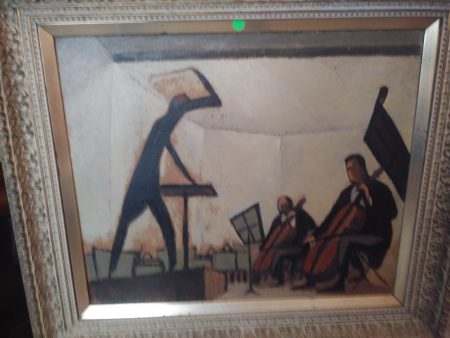Carolyn Shine, who died late last year at the age of 101, lived a life illuminated by visual arts and illuminated those arts for others. She was my colleague at the Cincinnati Art Museum, my friend before that, and always an example of life lived well.
A Cincinnatian by birth, Carolyn’s home from the beginning was in Clifton, the university section of the city, but she was a graduate of Bryn Mawr College as well as the Cincinnati Art Academy and also studied at the Art Students League. Her own art, very city-oriented, treated buildings and streetscapes and city scenes in general as seen by the artist’s transforming eye; her people were active, engaged, and slightly removed from realistic portrayal.
From 1947 through 1953 she showed regularly in exhibitions of Artists of Cincinnati and Vicinity and her work was also seen in shows presented by the Women’s Art Club of Cincinnati, the Town Club, the Woman’s Exchange and the Cincinnati Art Museum. She had a one-person exhibition at the Town Club in 1950 and her work was part of the Lending Gallery of Local Artists presented by Closson’s, a fashionable furniture store in the city. A newspaper story publicizing some of this activity shows her at the zoo, sketching one of its inhabitants, under the headline “A Kangaroo Poses for Miss C. Shine.” Another early newspaper story on her and her work, illustrated by her painting showing a boy carrying birds to market, still in their feathers, said “Miss Shine has a talent that has great promise for the future.”
From the mid-1940’s into the 1950s Carolyn was assistant to the director of Cincinnati’s Modern Art Society, which would later change its name to Contemporary Arts Center, cut its ties to the Art Museum and become the strong institution it is today. Her own interests stretched beyond contemporary work, however, and she left the Society to join the staff of the Cincinnati Art Museum as registrar, a post that meant she was curator in fact for anything that didn’t fit the Museum’s established departments. A particular portion of this material steadily enlarged, that relating to what people wear, and the Costume Department came to be with Carolyn as curator and someone else taking over the registrar post.
Museums were different in those days, sometimes more casual. At one of the staff meetings Carolyn would have attended a new acquisition, an ancient golden bowl known as the Darien Bowl, was presented by Museum Director Phillip Adams, filled by him with wine, and passed around for all to share. It stays in its display case these days, untouched by wine.
Another difference is that the staff was then tucked here and there about the building, sometimes a short staircase up to an office fitted into a corner or through a discreetly uninviting doorway. This meant that when a staffer left the desk he or she was promptly out among the art works, a reason perhaps that they tended to like their jobs. This still was true when I was working there, in public relations, and certainly one of the reasons I was glad to go to work. For many practical purposes the staff now works in the boxy addition perched atop the old Art Academy building with everyone in easy reach of one another, and of course they venture out from time to time into the actual halls of the Museum. But I think Carolyn and I both liked having the art as near neighbor.
Because Carolyn was a personal friend as well as colleague and often joined our family for holiday celebrations I asked our children (now grown) for memories. One remembers “visiting her behind the scenes. Many Native American artifacts in the office to catch the eye. She was carefully cleaning a new acquisition, a beaded belt, with a tiny vacuum cleaner, the size of pen, and also a small brush, working away, bead by bead.” Another memory: “She had a stylish little Nash Metropolitan car, black and white, looked sort of like a saddle shoe to me. And she had a puffy black and white skirt to match.”
I think Carolyn would be pleased to know that someone noticed and remembers that her car and skirt were compatible.






